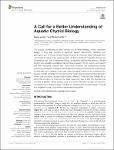A Call for a Better Understanding of Aquatic Chytrid Biology
| dc.contributor.author | Laundon, D | |
| dc.contributor.author | Cunliffe, M | |
| dc.date.accessioned | 2023-08-03T09:52:07Z | |
| dc.date.available | 2023-08-03T09:52:07Z | |
| dc.date.issued | 2021-08-04 | |
| dc.identifier.issn | 2673-6128 | |
| dc.identifier.issn | 2673-6128 | |
| dc.identifier.other | 708813 | |
| dc.identifier.uri | https://pearl.plymouth.ac.uk/handle/10026.1/21151 | |
| dc.description.abstract |
<jats:p>The phylum Chytridiomycota (the “chytrids”) is an early-diverging, mostly unicellular, lineage of fungi that consists of significant aquatic saprotrophs, parasites, and pathogens, and is of evolutionary interest because its members retain biological traits considered ancestral in the fungal kingdom. While the existence of aquatic chytrids has long been known, their fundamental biology has received relatively little attention. We are beginning to establish a detailed understanding of aquatic chytrid diversity and insights into their ecological functions and prominence. However, the underpinning biology governing their aquatic ecological activities and associated core processes remain largely understudied and therefore unresolved. Many biological questions are outstanding for aquatic chytrids. What are the mechanisms that control their development and life cycle? Which core processes underpin their aquatic influence? What can their biology tell us about the evolution of fungi and the wider eukaryotic tree of life? We propose that the field of aquatic chytrid ecology could be further advanced through the improved understanding of chytrid biology, including the development of model aquatic chytrids and targeted studies using culture-independent approaches.</jats:p> | |
| dc.format.extent | 708813- | |
| dc.format.medium | Electronic-eCollection | |
| dc.language | eng | |
| dc.publisher | Frontiers Media SA | |
| dc.subject | chytrid | |
| dc.subject | chytridiomycota | |
| dc.subject | saprotroph | |
| dc.subject | parasite | |
| dc.subject | aquatic | |
| dc.title | A Call for a Better Understanding of Aquatic Chytrid Biology | |
| dc.type | journal-article | |
| dc.type | Article | |
| plymouth.author-url | https://www.ncbi.nlm.nih.gov/pubmed/37744140 | |
| plymouth.volume | 2 | |
| plymouth.publication-status | Published online | |
| plymouth.journal | Frontiers in Fungal Biology | |
| dc.identifier.doi | 10.3389/ffunb.2021.708813 | |
| plymouth.organisational-group | |Plymouth | |
| plymouth.organisational-group | |Plymouth|Faculty of Science and Engineering | |
| plymouth.organisational-group | |Plymouth|Faculty of Science and Engineering|School of Biological and Marine Sciences | |
| plymouth.organisational-group | |Plymouth|REF 2021 Researchers by UoA | |
| plymouth.organisational-group | |Plymouth|Users by role | |
| plymouth.organisational-group | |Plymouth|Users by role|Academics | |
| plymouth.organisational-group | |Plymouth|REF 2021 Researchers by UoA|UoA07 Earth Systems and Environmental Sciences | |
| dc.publisher.place | Switzerland | |
| dcterms.dateAccepted | 2021-07-09 | |
| dc.date.updated | 2023-08-03T09:52:07Z | |
| dc.rights.embargodate | 2023-8-4 | |
| dc.identifier.eissn | 2673-6128 | |
| dc.rights.embargoperiod | forever | |
| rioxxterms.versionofrecord | 10.3389/ffunb.2021.708813 |


